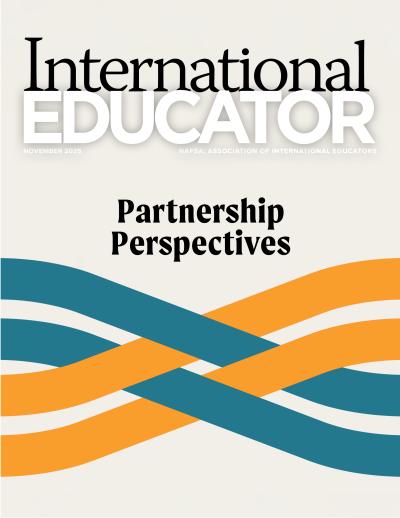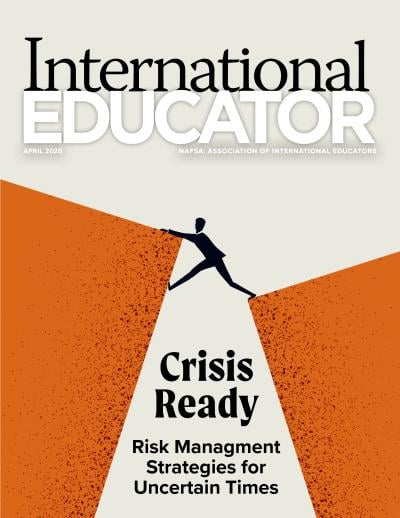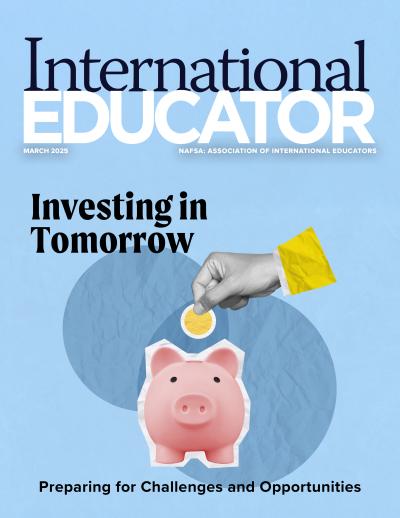Common Purpose

Most leaders in international education share a common challenge: helping their staff understand how their work connects to other parts of their office and campus. What does the alumni office have in common with international student advisers or admissions officers? And what do the parts of international education have in common with the university as a whole?
Connecting those dots so a team can succeed begins with identifying a shared purpose. “Purpose is the heartbeat of an organization,” says Ian Gibson, dean of the Global Campus at San Diego State University (SDSU). “It’s more than a statement—it’s the foundation of our identity, the grand aim that unites and inspires us.”
Translating inspiration into practice ensures that a team not only functions well but also feels ownership of its work. “Think of it as an inverted pyramid, where broad institutional purpose narrows into focused impact at every level,” says Gibson. “Ultimately, this flows to the individual, where aligning personal purpose with the organization’s mission creates the real magic—turning vision into action and ambition into achievement.”
Starting Points
Some universities have such a strong, well-defined mission—the top of the inverted pyramid—that staff members choose to be there because they align closely with that mission.
“Being at an HBCU [historically Black college or university], and Howard in particular, automatically offers us a ready-made purpose,” notes Tonija Hope Navas, director of the Ralph J. Bunche International Affairs Center at Howard University. “It’s not that other universities don’t have a purpose or mission, but HBCUs have a very particular mission. With that as a core, it’s easy to build around all the things we’re going to do as a team to achieve this purpose, goal, and mission.”
For other offices, building that shared foundation takes more effort. Staff members aren’t always aware of how their work relates to broader department and institutional goals, and leaders can get caught up in the crush of responsibilities. “A lot of times, we think there isn’t [time] in our workday to have conversations that help develop a sense of purpose,” says Cindy Schaarschmidt, executive director and senior international officer at Pierce College.
“It’s not just senior leadership setting strategy. A common sense of purpose is part of everyone’s DNA.” —Joël Gallegos
It’s important to be intentional in cultivating a sense of team purpose—starting with making sure everyone is involved from the outset. Though a shared purpose can start at the top of the inverted pyramid, “creating a sense of purpose is not hierarchical,” says Joël Gallegos, associate provost for international programs at the University of North Carolina-Charlotte. “That seems simple, but it’s often overlooked. It’s not just senior leadership setting strategy. A common sense of purpose is part of everyone’s DNA.”
Given the daily demands of an international office, it can be difficult to carve out time to thoughtfully approach this task, even when leaders realize its importance. Some leaders recommend taking advantage of periodic institution- or division-wide strategic planning.
Gallegos says the start of the pandemic in 2020 coincided with his school’s plans to develop a new strategic plan. Through a series of listening sessions, mostly through Zoom calls, staff had the opportunity to imagine a postpandemic world.
“We wanted everyone to see themselves in the plan, whether they were working with students, in partnership development, or in global learning,” Gallegos says. “I don’t know if we would have had such a strong common sense of collaboration and enthusiasm about the future if we hadn’t included everyone. We worked hard as individual units and a collective team, and we ended up with a blueprint for our work going forward.”
Gibson cites a similar example that strengthened his team. “Last year, SDSU Global Campus underwent a strategic reinvention, and uniting the team around a shared purpose was critical,” he says. “Instead of top-down directives and posters with corporate jargon, we invited everyone to participate in reimagining who we are and why we do what we do. What could have been an abstract exercise became a deeply personal mission.”
A Culture of Communication
While major initiatives present an opportunity to build a sense of purpose, the day-to-day work is equally important, starting with clear communication.
“Fostering a culture of transparency where information flows freely has never been easier with the popularity of tools like Slack and Teams,” Gibson says. Yet, despite these tools, fostering transparency still can be a challenge.
“When information is hoarded instead of shared, teams lose alignment and purpose fractures,” says Gibson. “This isn’t just a theoretical problem—it’s a logistical one. My organization spans floors, buildings, and even continents. Staying connected and aligned doesn’t happen by chance; it requires deliberate action.”
Similarly, how leaders interact directly with their teams makes a difference. “Communication and body language are key,” says Mahasweta Sarkar, senior associate dean of SDSU Global Campus and a professor of computer engineering. “Is it ‘I want this done’ or ‘Let’s get together to see if this can happen’?” Certain communication choices “motivate people to bring their ideas to the table.”
“Staying connected and aligned doesn’t happen by chance; it requires deliberate action.” —Ian Gibson
Sarkar brought together six teams on a project to lower the cost barrier for international students’ access to SDSU by making some classes available virtually before students needed to be on campus. A shared sense of purpose focused on the student experience contributed to the project’s success.
“All of these teams brought in their own expertise and experience working with partners,” she says. “It was fabulous to see how supportive they were. It enriched the program, to say the least.”
Individuals Matter
A shared purpose is only as effective as the people who inform it and own it. There are a few indicators of when a team is working from a common goal—though doing so doesn’t magically prevent common workplace irritations.
Schaarschmidt says this approach isn’t just about knowing the purpose but knowing the team members too. “Get to know everyone as individuals,” she says. “When you take time to interact in a social context, that creates more excitement and willingness to share with colleagues.”
Lindsay Vance, executive director of instructional design at SDSU Global Campus, agrees. “When I started, I interviewed each team member...to see what motivates them and how I can best support them,” she says. “It’s important to have the convergence of personal aspirations with what we are working on.”
There are clear signs when a team has a true sense of purpose; Sarkar says a sense of ownership is one. “The biggest [indicator] is when a team member sends a message saying, ‘I have this idea. Can we do this?’” she says. “They want to contribute, even though they are not required to.”
“There is a shared understanding or goal that we need to do the work, and that is a collective effort. ... All of us understand the work is important and recognition will come at the right time.” —Tonija Hope Navas
Schaarschmidt points to other clues that a team is functioning with a collective sense of purpose. “One small but important sign is that people are excited to come to work,” she says, and onboarding new staff is easier. “When new members come in, they see how the team functions,” says Sarkar. “When the culture is super-positive and collegial, any person coming into the team doesn’t really have another option.”
However, a team with a shared sense of purpose still experiences the usual workplace frictions. “I don’t think egos are missing,” notes Navas. “There is a shared understanding or goal that we need to do the work, and that is a collective effort. Not everyone is going to get all the shine one might want. All of us understand the work is important and recognition will come at the right time.”
“As a team, we have an agreement for creative differences,” says Vance. “What makes the content shine most? Those decisions become less about personal decisions and perspectives” and more about what serves students.
Even a strong team will occasionally falter. “Even the most functional family has challenges,” says Gallegos. “Where I see periodic challenges or little cracks, it’s because one of the units has a specific idea they want to advance, but we have to bring it back home,” he says. “It’s reminding everyone that the sense of purpose is not just one office.”
Shared Purpose, Lasting Impact
Gallegos points out that every team’s sense of purpose will be different. “You can’t pick up a positive sense of purpose and pop it into an institution,” he says. “You can give someone advice on what they can strengthen in their office, but to apply x, y, or z, there has to be recognition that everyone has to modify it based on the institution and its culture.”
With the right purpose and team buy-in, operating from a sense of purpose produces benefits for both staff and students—no matter the institutional differences.
“Purpose-driven work is simply better work,” says Gibson. “Teams produce higher-quality outcomes, stay adaptable in changing environments, and align their efforts with broader social values. And for students? A shared sense of purpose creates a stronger learning community, fostering deeper engagement, moral growth, and a sense of belonging. A common purpose drives teams toward meaningful, lasting impact.” •
About International Educator
International Educator is NAFSA’s flagship publication and has been published continually since 1990. As a record of the association and the field of international education, IE includes articles on a variety of topics, trends, and issues facing NAFSA members and their work.
From in-depth features to interviews with thought leaders and columns tailored to NAFSA’s knowledge communities, IE provides must-read context and analysis to those working around the globe to advance international education and exchange.
About NAFSA
NAFSA: Association of International Educators is the world's largest nonprofit association dedicated to international education and exchange. NAFSA serves the needs of more than 10,000 members and international educators worldwide at more than 3,500 institutions, in over 150 countries.
NAFSA membership provides you with unmatched access to best-in-class programs, critical updates, and resources to professionalize your practice. Members gain unrivaled opportunities to partner with experienced international education leaders.














